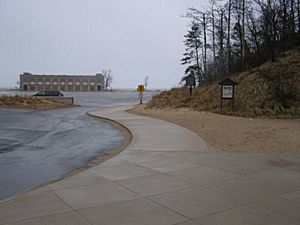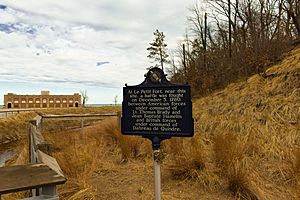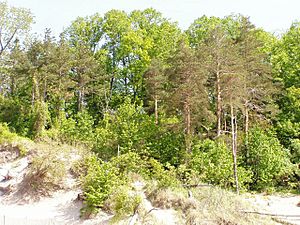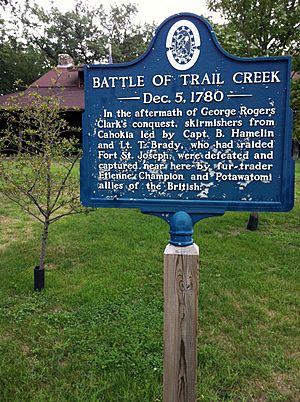Petit Fort facts for kids
Quick facts for kids Petit Fort |
|
|---|---|
| Petit Fort | |
| Porter, Indiana | |

Location of Petit Fort (signs on the right) on Lake Michigan, which is south of the Bathhouse
|
|
| Coordinates | 41°39′39″N 87°03′44″W / 41.660798°N 87.062359°W |
| Site history | |
| Built | 18th century |
| Built by | French |
| In use | Fur Trade Post |
| Demolished | 1779 |
| Battles/wars | American Revolution |
Petit Fort was a small building in northwestern Indiana. It was located near the Indiana Dunes, close to where a stream called Dunes Creek meets Lake Michigan.
Historians are not sure if Petit Fort was a military outpost for the French. It was more likely a private home, a place for trading goods, or a support station for bigger forts nearby. The National Park Service calls it a "fur depot," which means it was a place where animal furs were collected and stored for trade.
After the French and Indian War, the British took control of the area. It's not clear if the British used Petit Fort much. If they did, it was probably just a small stop for British fur traders. The fort was left empty in 1779. This happened because American settlers were fighting for independence in the American Revolution. Great Britain was moving its forces to stronger forts.
There are not many records about Petit Fort. It is mentioned in only a few old letters and on one map. The name "Petit Fort" is actually a description. It means "small fort" in French. It is mostly remembered because of a small battle that happened there during the American Revolution.
The Battle of Petit Fort
In late 1780, a small group of about fourteen Creole men left Cahokia, Illinois. They were ordered by Augustin de La Balme to attack Fort St. Joseph. This fort was controlled by the British and was located in southwest Michigan.
The group was led by Jean Baptiste Hamelin and Lt. Thomas Brady. Brady was a former British officer who now supported the American rebels. As they traveled, more people joined them from frontier settlements. Their group grew to about thirty men.
They traveled along rivers and then walked across land to reach Fort St. Joseph. They attacked the fort and took many valuable items, mostly trade furs. The raid was planned for a time when local Native American hunters would be away. La Balme also hoped this raid would distract the British from his own journey to attack Fort Detroit.
The raiders started their journey back, carrying the furs on pack-horses. But a British officer, Lt. Dagreaux Du Quindre, found out about the raid. He quickly gathered a group of loyal traders and Potawatomi warriors. The Potawatomi were led by Chief Anaquiba and his son, Topeneble.
Du Quindre's group followed Brady's company. They caught up to them in the sandy dunes south of Lake Michigan. A chase began through the dunes. Finally, the raiders took up defensive positions at Petit Fort.
Major DePeyster reported on the battle in a letter on January 8, 1781. He said that the American group, led by Jean Baptiste Hammelain, arrived at St. Joseph's when most of the Native Americans were away hunting. They captured the traders and took all the goods, including many bales of furs.
Lt. Du Quindre quickly gathered Native Americans and chased the raiders to Petit Fort. On December 5, he asked them to surrender. When they refused, he ordered his Native American allies to attack. Du Quindre's side did not lose anyone. They killed four of the raiders, wounded two, and captured seven. The other three escaped into the thick woods.
Three of the captured men were brought to Du Quindre's location, including Brady. The other prisoners were taken by the Native Americans. DePeyster considered these raiders to be "robbers" rather than prisoners of war. This was because they did not seem to have official military orders.
Images for kids





